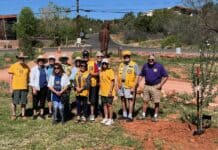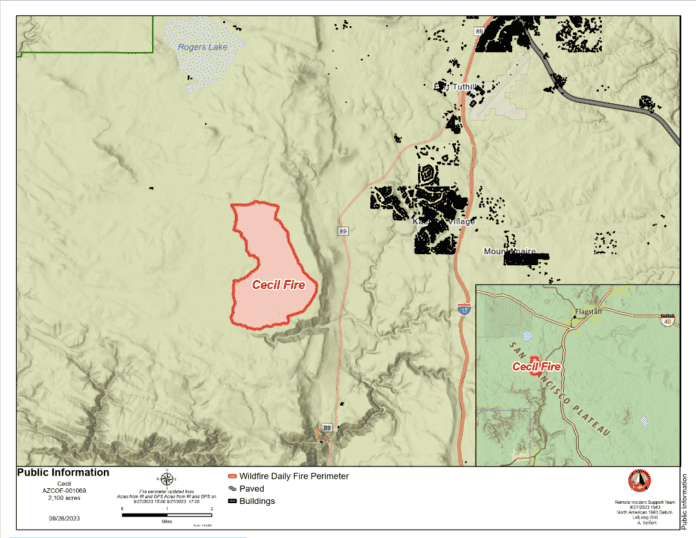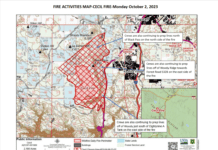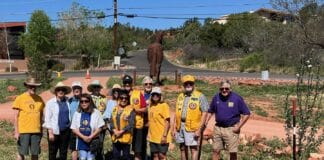Firefighters are halting firing operations on both the Cecil and Still fires in advance of forecast increased wind speeds.
Both fires have been staffed with additional firefighters who plan to spend the weekend holding and securing existing fire line.
So far, crews have successfully treated a combined 2,500 acres of Coconino National Forest land on both the Flagstaff Ranger District and the Mogollon Rim Ranger District due to both lightning-caused fires.
Land treatment removes fuels – such as dead trees and pine needle accumulation – from the forest floor to reduce the risk of high-intensity wildfire.
Both the Cecil and Still fires are being managed to reduce those hazardous fuels and improve forest health as guided by Forest Service’s 10-year Wildfire Crisis Strategy.
Cecil Fire
The Cecil Fire, located southwest of Flagstaff, was reported at 2,180 acres Thursday morning.
It is burning on both Coconino NF and Arizona State Trust lands, and a closure order has been issued for the fire area.
Fire managers do not plan to conduct additional firing operations this week due to a forecast increase in wind speeds. Fire managers are utilizing the next two days before the wind event to secure the current fire edge on all sides of the fire.
Relative humidities at night are in the 80-90% range, which saturate the fine fuels and decrease their ability to accept and spread fire, which is working in the firefighters’ favor.
Resources assigned to the Cecil Fire include two Hotshot crews, two hand crews, two engines, a dozer, a water tender and miscellaneous overhead.
One additional hand crew has been added to the resources already in place to help hold the fire during the wind event.
During the wind event, crews will be deployed across the fire perimeter to continue to secure the fires edge. Crews are also continuing to prep lines on the north and east sides of the fire for the possibility of additional firing operations next week if conditions allow.
While smoke impact will decrease over the coming days, smoke will remain noticeable in both the Flagstaff and Sedona areas as well as along 89A.
There are no structures at risk.
The Cecil Fire was first reported Sept. 18 and is burning in Ponderosa pine.
Flagstaff residents and Coconino NF visitors can check InciWeb for fire updates throughout the coming days.
Still Fire
The Still Fire, located 4 miles northeast of the Highway 87 and Lake Mary Road junction, is roughly 300 acres following successful firing operations conducted Wednesday.
Fire managers are conducting firing operations on the Still Fire throughout the day today and aspire to have an additional 1,200 acres of land treated by the end of today’s operations.
Following today’s operations, crews will pivot and begin holding and securing existing fire line in advance of the weekend winds.There are no structures threatened by the Still Fire, which is burning through pine litter.
Roughly 41 personnel are assigned to the Still Fire, including three engines, one Hotshot crew, one fuels crew, a dozer and miscellaneous overhead.
Forest visitors and motorists can expect smoke impacts in the Blue Ridge communities, along Highway 87 and in the Little Springs area.
The Arizona Department of Transportation will be assisting motorists along Highway 87 during firing operations for public safety.
Highway 87 may close at any time for public safety and motorists are reminded to check the Arizona Department of Transportation website for information regarding state road closures.
Motorists are asked to remain cognizant of firefighting operations and to expect traffic delays.
While there are no road, trail or area closures in effect at this time, a closure order will likely be implemented soon and forest visitors are asked to abide by all posted signage and barriers.
The Still Fire was first reported Sept. 14, and updates can be found on InciWeb.
Smoke and Future Wildfire Mitigation
The Coconino NF is a fire-adapted ecosystem, which needs incremental fire to maintain forest resiliency.
We recognize smoke can be impactful and inconvenient for area residents and visitors. Managing these fires and reducing the hazardous fuels in these areas of the forest under the current weather conditions will temporarily produce heavy smoke impacts, but it will also reduce the amount of fuel on the ground and help protect communities from high-intensity wildfires. If a future wildfire starts in this area, it will be more manageable and it will result in fewer overall smoke impacts to the communities.
For current information on smoke, visit the Fire and Smoke Map via airnow.gov.





















